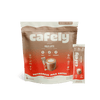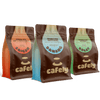Keeping your coffee brewing equipment clean can seem like a never-ending chore, especially if you drink several cups per day. However, there are plenty of tricks and tips to reduce the time you spend cleaning.
In your Keurig coffee maker, mineral buildup, coffee residues, and milk powders that accumulate over time can affect the machine’s performance and the taste of your brews. The good news? The cleaning process is relatively simple.
In this guide, you learn how to properly clean and maintain your Keurig coffee maker to ensure it brews the best coffee possible.
A Step-by-Step Guide: Cleaning Your Keurig Coffee Maker

Your Keurig is made up of several different interconnected parts and mechanisms. These sections require cleaning in different ways and on different schedules.
Let’s go through each element and how to clean them individually:
1. Cleaning the Removable Parts
The removable parts — the drip tray, water tank, and pod holder — require cleaning the most often, as they tend to get dirty the quickest. This is also a great time to wipe down the outside of the Keurig to remove any stains or splatters.
Here’s how to clean the removable parts on your Keurig:
- Turn off and unplug the machine.
- Remove the machine’s water reservoir, lid, drip tray, and K-Cup holder from the machine. Remove the water filter from within the reservoir and set it to one side — this doesn’t need cleaning.
- Wash each of the parts by hand with warm water and a mild detergent.
- Rinse each part thoroughly.
- Gently towel-dry the parts to remove excess water, or let them air-dry for an hour or so.
- Once all the parts are dry, reassemble the coffee maker and plug the machine back in.
2. Cleaning the Needles
Each Keurig machine will have a set of small needles that it uses to puncture the coffee pods so the hot water makes its way through the pod and brews the coffee. Coffee grounds and oils can get stuck to these needles, which may prevent them from working properly.
Here’s how to clean the needles on a Keurig:
- Turn off and unplug the Keurig.
- Remove the pod holder.
- Using a toothpick, remove any debris from the hole at the base of the holder. Then, carefully wash the pod holder with warm, soapy water.
- Next, find the entrance needles. Depending on the size and shape of your machine and your countertops, you may need to lie your machine on its side for access.
- Gently clean the needles with a dishcloth, warm water, and a mild detergent.
- Wipe clean with a damp cloth to remove the detergent.
- Reassemble the pod holder and funnel, and then place it back into the machine.
- Fill the water reservoir with clean water and run the Keurig twice. This will rinse out any dislodged debris or detergent.
3. Replacing the Water Filter
Not all Keurig coffee makers have water filters. If yours does, it will be in the water reservoir. While the water filter itself doesn’t need cleaning, it’s essential to replace it regularly. If the filter isn’t replaced, your coffee will taste worse over time, and mold or other impurities could build up in the filter.
Filters have a lifespan based on how much water passes through them. If you’re using your Keurig several times per day, you may need to change the filter every month. If you’re only using it once weekly, it may only need replacing every three months.
Here’s how to replace the filter on your Keurig:
- Soak the new filter in water for around five minutes. This will allow the chemical reactions within the filter to start and wash away any impurities the filter may have.
- Complete this washing process by rinsing the new filter under running water for around a minute.
- Remove the water filter holder from the Keurig’s water reservoir and wash it in warm, soapy water. Rinse and dry it thoroughly.
- Place the new filter into the filter holder.
- Insert the filter holder back into the reservoir and fill the reservoir as normal.
4. Descaling Mineral Buildup
You won’t need to descale your Keurig regularly. However, if the water in your region is particularly hard and you use the machine regularly, it may need to be done once every three to six months.
Here’s how to descale your Keurig:
- Remove the water filter from the water reservoir.
- Fill the reservoir with a fifty-fifty mixture of distilled white vinegar and water. Keurig also sells a descaling solution for this purpose — if using, dilute a sachet according to the instructions on the packet.
- Place a large mug onto the drip tray, and lift the pod handle on the coffee maker.
- Select your machine's largest cup size, and brew a cup as normal before discarding the water.
- Repeat this process until the “Add Water” indicator is lit.
- Let the coffee maker sit for 30 to 45 minutes. This will allow the vinegar or descaler in your machine to dissolve any mineral buildup.
- Empty any liquid left in the reservoir and wash it thoroughly with soapy water before rinsing.
- Fill the reservoir to the max line with fresh water, and then brew around 12 large cups. This ensures all of the vinegar or descaling solution is purged from the machine.
- Finally, re-insert or replace the water filter and top up the water reservoir as needed.
Why Is It Important to Keep Your Keurig Clean?
Keeping your Keurig as clean as possible ensures that each pod brewed is extracted perfectly.
Here’s why it’s important to keep your Keurig clean:
Flavor
The main reason it’s vital to keep your Keurig clean is flavor. K-Cups are packed with flavor, but a dirty Keurig may mask or taint the taste of the blend within the pod once it’s brewed.
Most problems with flavor stem from the mineral buildup (limescale) within the machine. Limescale can give the water it comes into contact with a flat, stale flavor. For this reason, you might notice the best improvements in flavor after descaling your coffee maker.
The flavor of your coffee may also be tainted by a residual buildup of coffee oils, mold or dirt in your water filter, or grim in the spout of the pod holder. Keep each element clean to ensure each cup tastes as good as the last.
Machine Longevity
Taking care of any tool or machine will increase its lifespan. In the case of a Keurig coffee maker, regular cleaning and maintenance puts less stress on the internal pump and other components in the machine. Clean components work more effectively and efficiently — reducing wear and increasing their longevity.
The most effective way to put less strain on your Keurig machine is to descale it regularly. Any mineral buildup in the machine increases water pressure. This puts more strain on the pump itself, potentially leading to a failure.
Quick Clean vs. Deep Clean

As with most kitchen appliances, Keurigs need different levels of cleaning and maintenance at different times. A quick clean is typically a two-minute task and should be done around once per week. A deep clean is more involved and should be done semi-regularly (once every few months).
Quick Clean — Once per week
A quick clean is simple and typically involves washing the removable parts and wiping down the needles and exterior of the machine. This regular maintenance prevents the buildup of oils, grounds, and coffee stains that may damage your machine in the long term.
To do a weekly quick clean, wash the removable parts of the machine in warm, soapy water before drying them thoroughly and reattaching them. Wipe down the machine's needles with a damp cloth to remove debris, and clean the outside of the machine to remove any dust or coffee residue that may have formed through general use.
Deep Clean — Once per Two to Three Months
To ensure the internal components of your Keurig are functioning as intended, you should deep clean every two to three months. This process involves replacing the water filter and descaling the machine.
Doing both at once is the most efficient way of completing this process because you have to soak the filter for a long period. The descaling process is also lengthy. By doing these tasks at once, you can effectively ensure that your Keurig is clean as quickly as possible.
Common Cleaning Mistakes To Avoid With Your Keurig
People often make key mistakes when cleaning a Keurig. Here’s what to look out for when cleaning your Keurig:
1. Not Rinsing Thoroughly
Thoroughly Rinsing your Keurig is important after cleaning, no matter what type of cleaning you’ve done.
In the case of descaling, you may use either white vinegar or Keurig’s descaling solution. Both options contain acidic chemicals that break down the limescale within your machine. If you don’t thoroughly rinse the machine after descaling, these chemicals will end up in your coffee.
In the case of cleaning with soapy water, the soap can leave chemicals in your machine. While these chemicals may not do you any harm, they’ll certainly make your coffee taste terrible. Make sure to rinse your machine, regardless of whether you’ve done a “quick clean” or a “deep clean.”
2. Not Drying Thoroughly
Before air drying the parts of your Keurig, you need to wipe away the larger pools of water with a microfiber towel or paper towel. This will ensure the parts are completely free from any residue from cleaning solutions while also preventing any small pieces of thread or lint from getting into your machine.
Leaving moisture in the machine after cleaning may also lead to mold. When you take apart your Keurig for cleaning, make sure to dry each part thoroughly before resembling it to prevent this.
3. Not Unplugging the Machine Before Cleaning
While this may seem obvious, it’s still important to point it out. Electricity and water don’t mix, so even with the shielding and safety measures that your Keurig undoubtedly has, it’s still wise to separate the two.
Turn off and unplug your machine before you start disassembling and cleaning it — this will make the whole process much safer.
Different Keurig Models Have Different Cleaning Requirements
There are many different Keurig models, all of which have slightly different features and parts. The broad strokes of cleaning these different machines will remain the same, but some machines may have specialized maintenance requirements.
Check The Manual
If you believe that your Keurig might have some special needs that general cleaning doesn’t quite suit, consult the manual that came with your machine. The manual will have a section dedicated to cleaning and maintenance, so it’s a useful resource.
FAQs: Cleaning Your Keurig Coffee Maker
Cleaning your Keurig coffee maker can seem like a chore, but learning the best methods to keep the machine clean will easily improve your coffee experience.
Check out the answers to the FAQs below to learn more…
1. What’s the Best Way to Clean a Keurig Coffee Maker?
You’ll have to use different methods to clean the unique components in a Keurig machine. For example, you’ll need to wash all of the removable parts in warm, soapy water and then dry and reinstall them. The needles should be cleaned, wiped down, and rinsed. The entire machine should be descaled with white vinegar or a similar solution every three to six months to ensure good function.
2. Should You Run Vinegar Through a Keurig to Clean It?

Yes, running vinegar through a Keurig will dissolve and remove mineral deposits within the machine. For best results, run a full tank of equal parts vinegar and water (a natural descaling solution) through the machine every three to six months.
3. What Button Do You Press to Descale a Keurig?
This will differ between Keurig's models — some machines have specific descaling functions. However, the general method for machines without this function is to fill the tank with a descaling solution and dispense the largest volume of water possible into a mug. Dump the mug out, and repeat this process until the “refill tank” light is lit. Wait for 30 to 45 minutes, and then repeat the process with clean water to rinse the machine.
4. What Is the Ratio of Vinegar to Water to Clean a Keurig Coffee Maker?
The ideal ratio is equal parts distilled white vinegar and water. However, if you’ve never descaled the coffee maker, it may be wise to increase the vinegar-to-water ratio the first time to remove stubborn build-up.
5. How Many Times Should You Rinse a Keurig After Cleaning With Vinegar?
Ideally, you should run at least one full tank of clean water through the machine to rinse out any remnants of mineral deposits or vinegar. Most people recommend running at least 12 large cups through the machine after descaling.
6. How Do I Clean a Keurig Without Vinegar?
The best alternative to vinegar is Keurig’s descaling solution, which is diluted and used in the same way as vinegar. However, you may find that vinegar is a more affordable choice.
7. What Happens if You Don’t Descale Your Keurig?
If you don’t descale your Keurig, mineral deposits will build up within the machine’s internal mechanisms. This will cause the internal pump to use more pressure to force water through the system, decreasing the pump's lifespan and possibly causing the machine to break.
8. How Can You Tell If Your Keurig Is Clogged?
The easiest way to tell if your Keurig is clogged is to keep an eye on the rate at which coffee flows out. If the liquid flows notably more slowly, there’s likely a blockage within the system, and a deep clean is required.
9. How Do I Clean the Gunk Out of My Keurig?
To remove coffee grounds, oils, and limescale from your Keurig, run a vinegar and water solution through the machine before rinsing with clean water.
10. Does Mold Build Up in Keurig?
Yes, this can happen. It most commonly occurs when the Keurig is filled with water and then left unused for long periods. Mold can grow in the water reservoir, pod holder, and water filter. Regularly cleaning and maintaining your Keurig is the best way to prevent this.










